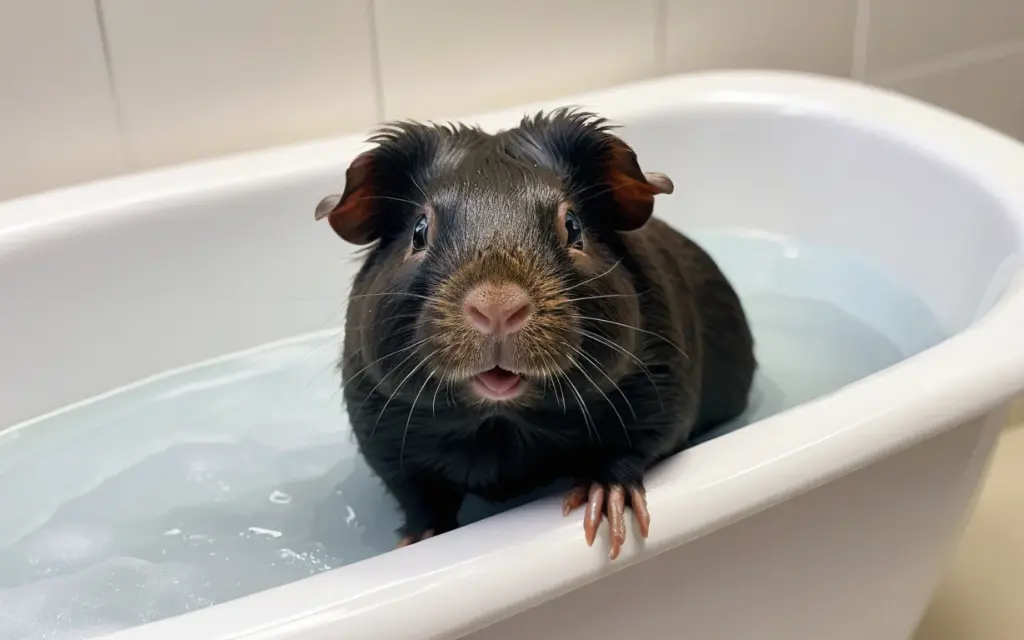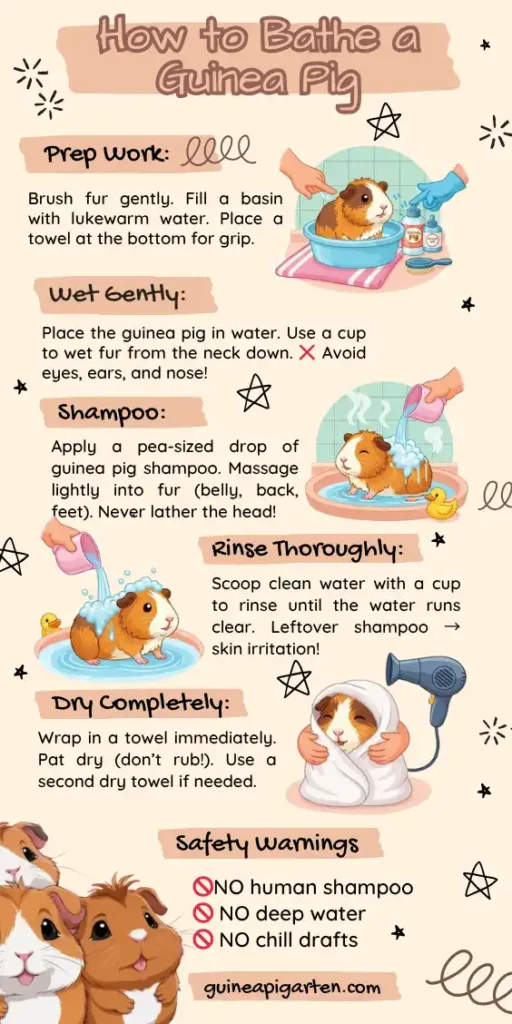Guinea pigs are not very fond of water, so bathing them can be a somewhat difficult task for a piggy parent. To give a stress-free bath to these tiny rodents, you need to have the right approach.
With gentle care, their bath time can become a calm and bonding experience. Here you get to know everything about bathing a guinea pig and helping them stay healthy, clean, and safe.
Why is bathing necessary and when to avoid it?

An occasional bath is enough to keep your beloved pet clean, as these furballs groom themselves regularly and thus are naturally clean. Here’s why bathing matters.
- Bathe your piggy whenever there is visible dirt or odor, like debris stuck in its fur, urine stains, or muddy paws.
- Bathing is important if your piggy has urine scalds, fungal infections, or is prescribed by a vet for parasite treatments.
- Piggies with long hair need extra maintenance. Bathing can help in removing the dirt that gets trapped in their fur.
- Avoid bathing if your piggy is stressed / sick, or under 4 months old.
- Bathing frequently can strip natural oils, leading to dry skin.
- Your piggy is self-grooming itself and is naturally clean/healthy.
Essential items for a stress-free bath
Keep essential supplies handy to keep the bathing process smooth and faster.
- Shampoo: Avoid using dog or human shampoo as they are too harsh. Always use a pH-balanced shampoo for small animals. You can use good brands like Gorgeous Guinea or Burgess Excel.
- A container: Use a shallow plastic tub or sink filled with 1 to 2 inches of lukewarm water. The water temperature should be approximately 85°F.
- Rubber mat: Using a rubber mat or towel can be a good idea to prevent slipping.
- Towels: Always use a microfiber, a soft towel to dry your piggy after bath.
- A cup: for rinsing, using a pitcher or a cup is perfect.
- A brush: To manage the long-haired breeds, use a soft, small brush.
Pre-bath preparation
- To avoid any scratches during bathing, trim the nails of your guinea pig or use nail clippers.
- Bathing should be conducted in a draft-free, warm room with a temperature of around 75°F. Keep the shampoo, treats, and towels handy.
- Before bathing, hold your piggy gently for 5 to 10 minutes and speak softly to it. For comfort and to calm your pet, place a fleece blanket in the tub that they are familiar with.
How to bathe a guinea pig? Step-by-step guide
Attention, patience, and gentleness can help a piggy owner to bathe their beloved pet safely. Following the steps below will help you ensure your piggy stays healthy and feels safe throughout the process.
Step 1: Bath area preparation
- Pour lukewarm water with a temperature around 85 to 90 degrees Fahrenheit into a shallow sink or tub.
- The water should feel neutral, that is neither too hot or cold. You can use a thermometer or your wrist to test the temperature of the water.
- Fill the tub or sink with 1 to 2 inches of water. Guinea pigs can panic in deep water. So, avoid using it. Never submerge their head in water as water can enter their ears or nose.
- To prevent slipping, place a folded fleece, small towel, or rubber mat at the bottom of the tub.
Step 2: Place your piggy in water gently
- While placing your guinea pig in water, ensure you hold them securely. Support their hindquarters with one hand and their chest with the other.
- Make sure their head stays elevated and above the water throughout the process.
- To acclimate, place them slowly in water. Let their paws touch the water first.
- To make them relax and stress-free, use a soft voice and speak calmly all the time.
Step 3: Application of shampoo
- Always use a pea-sized amount of shampoo developed for guinea pigs to maintain the pH balance of their sensitive skin. Using brands like Gorgeous Guinea and Burgess Excel can be the best options.
- Focus on the dirty areas and massage them gently using your fingertips in small circles. As the skin of a guinea pig is quite delicate, so avoid scrubbing.
- To prevent tangles, work shampoo through the fur for long-haired breeds.
Step 4: Rinse properly
- Leftover shampoo can cause infections, itching, or dryness. So, rinse 2 to 3 times to ensure no residue remains.
- Check for soapy spots and keep rinsing. Run your fingers through their fur to check if it feels slick.
- Pour clean water over them using the cup method. Avoid the head.
Step 5: Dry completely
- At first, use a towel to dry them. Wrap your furry friend in a soft, absorbent towel and pat gently. Rubbing can irritate skin or tangle fur. So, avoid it.
- The blow dryer should only be used if necessary. Hold the dryer more than 12 inches away and set it to low heat. To prevent overheating at one spot, keep the dryer moving.
- To prevent mats, use a wide-tooth comb to brush long-haired breeds when their fur is slightly damp.
Dos and Don’ts of Drying Your Guinea Pig
| Do | |
|---|---|
| 1 | Hold a heat blow dryer more than 12 inches away for drying your furry friend. |
| 2 | To prevent mating, brush long-haired breeds. |
| 3 | You can pat dry with a towel. However, do not rub. |
| Don’ts | |
|---|---|
| 1 | As these piggies overheat easily, avoid using high-heat dryers. |
| 2 | When they are damp, return them to a cold room. |
| 3 | 10 inches away for drying your furry friend. |
After bath care
- To reinforce positive associations, reward them with treats after bathing.
- Use fresh, dry material to replace their wet bedding. Cleaning their habitat after bathing can help them stay clean and fresh for longer.
- Make sure they are acting normally, eating, and moving after bathing.
What are the common mistakes you need to avoid when bathing your guinea pig?

Using harsh shampoos
Using shampoo meant for humans or other animals can strip natural oils from a guinea pig’s skin, as they are formulated for a more acidic skin pH. Harsh shampoos contain ingredients like parabens, sulphates, or fragrances that can make their skin itchy, dry, and prone to infections.
Over bathing
Guinea pigs do need to be bathed frequently. Overbathing removes the natural oils in their skin and leads to skin issues like dermatitis, flakiness, or dryness.
Ignoring the rinse
Leftover shampoo can lead to bacterial infections. Skipping the rinse can irritate their skin and cause redness, allergic reactions, and itching.
Ignoring stress-signals
Forcing a stressed-out piggy to bathe can traumatize them. Even if they cannot speak, you will understand that your pet is scared by their body language. Forceful bathing can also make future grooming harder.
Leaving them wet
Guinea pigs with damp fur can struggle to regulate body temperature, which can lead to hypothermia. Leaving your piggy wet can also foster fungal growth.

Take away
Staying calm while bathing a guinea pig is important, as these little pets pick up on your energy. Always keep the bath time short, i.e., a maximum of 5 to 10 minutes. Veggie treat post-grooming can be paired with bath time.
Bathe your piggy every 2 to 3 months, unless medically necessary. This will help avoid stress and health issues.
